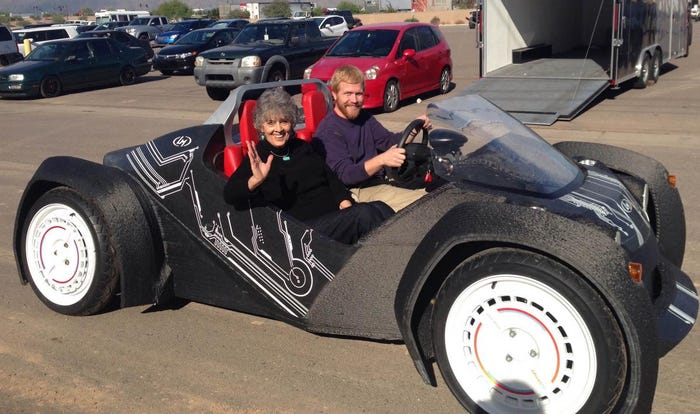As I rode around the parking lot at the Local Motors manufacturing plant in Chandler, AZ, in the company's Strati - the 3D printed car that stole the show at IMTS, I thought back to when I first started writing about this thing called "rapid prototyping." [PlasticsToday first covered the 3D printed car in September: Carbon fiber-reinforced material used to fabricate
December 10, 2014
As I rode around the parking lot at the Local Motors manufacturing plant in Chandler, AZ, in the company's Strati - the 3D printed car that stole the show at IMTS, I thought back to when I first started writing about this thing called "rapid prototyping." [PlasticsToday first covered the 3D printed car in September: Carbon fiber-reinforced material used to fabricate world's first 3D printed vehicle].
Now here I was more than two decades later riding around in a 3D printed car. Granted the surface finish was a bit rough. The interior looked a bit like a volcanic lava flow. But I had to admit that this industry has come a long way from the days of RP (rapid prototyping) to riding in a 3D printed car.
Rapid prototyping was just that: it was quick way to build a solid part using powdered plastic sintered with a laser system (SLS) into a rather rough-surfaced part. That part wasn't good for much except to prove a concept or to show marketing or to take to a trade show. There weren't many materials to choose from either. So all in all it was pretty limited in both applications and materials.
|
Clare Goldsberry taking a ride in the world's first 3D-printed car at the the Local Motors facility in AZ. |
Today, the 3D printing process is officially called additive manufacturing (AM) because it's gone from being a method of producing a touchy-feely part to "manufacturing" actual end use parts in a wide variety of materials - both plastic and metal (with direct metal laser sintering) - for a range of applications in nearly every industry.
Local Motors, along with Cincinnati Inc.'s BAAMci large-scale additive manufacturing system located at Oak Ridge National Laboratory where the R&D for the Strati was done, built the car in 44 hours of carbon reinforced ABS material. The car has fewer than 50 parts, and runs on an electric motor.
Like General Electric's FirstBuild micro-factory - where "ideas grow into real products" - Local Motors is also a micro-factory where co-creation is key to the development of the company's products. The facility is filled with engineers and idea people in large, open rooms filled with computers and MakerBot 3D printers. The creative energy at Local Motors is almost palpable!
Local Motors created the Rally Fighter vehicle used in the making of the movie Transformers 4: Age of Extinction. The company also makes DIY Rally Fighter kits in which buyers of these cars can come to the factory and build 51% of the car themselves.
Local Motors has other ideas for 3D printing as well such as 3D printing the molds to use in thermoforming various exterior and interior car parts. By 3D printing the molds, the company can design on the fly and change parts quickly, and at a fraction of the cost of building traditional aluminum molds.
We live in a manufacturing world in which change is happening fast, and being ready for change - adapting to change and making change work for us in our businesses - is the key to our future success.
About the Author(s)
You May Also Like





